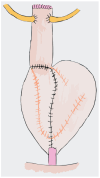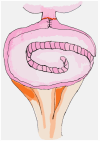Advances in Urinary Diversion: From Cutaneous Ureterostomy to Orthotopic Neobladder Reconstruction-A Comprehensive Review
- PMID: 38673019
- PMCID: PMC11051023
- DOI: 10.3390/jpm14040392
Advances in Urinary Diversion: From Cutaneous Ureterostomy to Orthotopic Neobladder Reconstruction-A Comprehensive Review
Abstract
Bladder cancer ranks as the 10th most prevalent cancer globally with an increasing incidence. Radical cystectomy combined with urinary diversion represents the standard treatment for muscle-invasive bladder cancer, offering a range of techniques tailored to patient factors. Overall, urinary diversions are divided into non-continent and continent. Among the first category, cutaneous ureterostomy and ileal conduit represent the most common procedures while in the second category, it could be possible to describe another subclassification which includes ureterosigmoidostomy, continent diversions requiring catheterization and orthotopic voiding pouches and neobladders. In this comprehensive review, urinary diversions are described in their technical aspects, providing a summary of almost all alternatives to urinary diversion post-radical cystectomy.
Keywords: bladder cancer; ileal conduit; orthotopic neobladder; ureterostomy; urinary diversion.
Conflict of interest statement
The authors declare no conflicts of interest.







